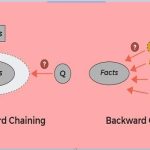In artificial intelligence, forward and backward chaining is one of the important topics, but before understanding forward and backward chaining lets first understand that from where these two terms came.
Inference engine:
The inference engine is the component of the intelligent system in artificial intelligence, which applies logical rules to the knowledge base to infer new information from known facts. The first inference engine was part of the expert system. Inference engine commonly proceeds in two modes, which are:
a. Forward chaining
b. Backward chaining
Horn Clause and Definite clause:
Horn clause and definite clause are the forms of sentences, which enables knowledge base to use a more restricted and efficient inference algorithm. Logical inference algorithms use forward and backward chaining approaches, which require KB in the form of the first-order definite clause.
Definite clause: A clause which is a disjunction of literals with exactly one positive literal is known as a definite clause or strict horn clause.
Horn clause: A clause which is a disjunction of literals with at most one positive literal is known as horn clause. Hence all the definite clauses are horn clauses.
Example: (¬ p V ¬ q V k). It has only one positive literal k.
It is equivalent to p ∧ q → k.
A. Forward Chaining
Forward chaining is also known as a forward deduction or forward reasoning method when using an inference engine. Forward chaining is a form of reasoning which start with atomic sentences in the knowledge base and applies inference rules (Modus Ponens) in the forward direction to extract more data until a goal is reached.
The Forward-chaining algorithm starts from known facts, triggers all rules whose premises are satisfied, and add their conclusion to the known facts. This process repeats until the problem is solved.
Properties of Forward-Chaining:
o It is a down-up approach, as it moves from bottom to top.
o It is a process of making a conclusion based on known facts or data, by starting from the initial state and reaches the goal state.
o Forward-chaining approach is also called as data-driven as we reach to the goal using available data.
o Forward -chaining approach is commonly used in the expert system, such as CLIPS, business, and production rule systems.
Consider the following famous example which we will use in both approaches:
Example:
“As per the law, it is a crime for an American to sell weapons to hostile nations. Country A, an enemy of America, has some missiles, and all the missiles were sold to it by Robert, who is an American citizen.”
Prove that “Robert is criminal.”
To solve the above problem, first, we will convert all the above facts into first-order definite clauses, and then we will use a forward-chaining algorithm to reach the goal.
Facts Conversion into FOL:
o It is a crime for an American to sell weapons to hostile nations. (Let’s say p, q, and r are variables)
American (p) ∧ weapon(q) ∧ sells (p, q, r) ∧ hostile(r) → Criminal(p) …(1)
o Country A has some missiles. ?p Owns(A, p) ∧ Missile(p). It can be written in two definite clauses by using Existential Instantiation, introducing new Constant T1.
Owns(A, T1) ……(2)
Missile(T1) …….(3)
o All of the missiles were sold to country A by Robert.
?p Missiles(p) ∧ Owns (A, p) → Sells (Robert, p, A) ……(4)
o Missiles are weapons.
Missile(p) → Weapons (p) …….(5)
o Enemy of America is known as hostile.
Enemy(p, America) →Hostile(p) ……..(6)
o Country A is an enemy of America.
Enemy (A, America) ………(7)
o Robert is American
American(Robert). ……….(8)
Forward chaining proof:
Step-1:
In the first step we will start with the known facts and will choose the sentences which do not have implications, such as: American(Robert), Enemy(A, America), Owns(A, T1), and Missile(T1). All these facts will be represented as below.

Step-2:
At the second step, we will see those facts which infer from available facts and with satisfied premises.
Rule-(1) does not satisfy premises, so it will not be added in the first iteration.
Rule-(2) and (3) are already added.
Rule-(4) satisfy with the substitution {p/T1}, so Sells (Robert, T1, A) is added, which infers from the conjunction of Rule (2) and (3).
Rule-(6) is satisfied with the substitution(p/A), so Hostile(A) is added and which infers from Rule-(7).

Step-3:
At step-3, as we can check Rule-(1) is satisfied with the substitution {p/Robert, q/T1, r/A}, so we can add Criminal(Robert) which infers all the available facts. And hence we reached our goal statement.

Hence it is proved that Robert is Criminal using forward chaining approach.


